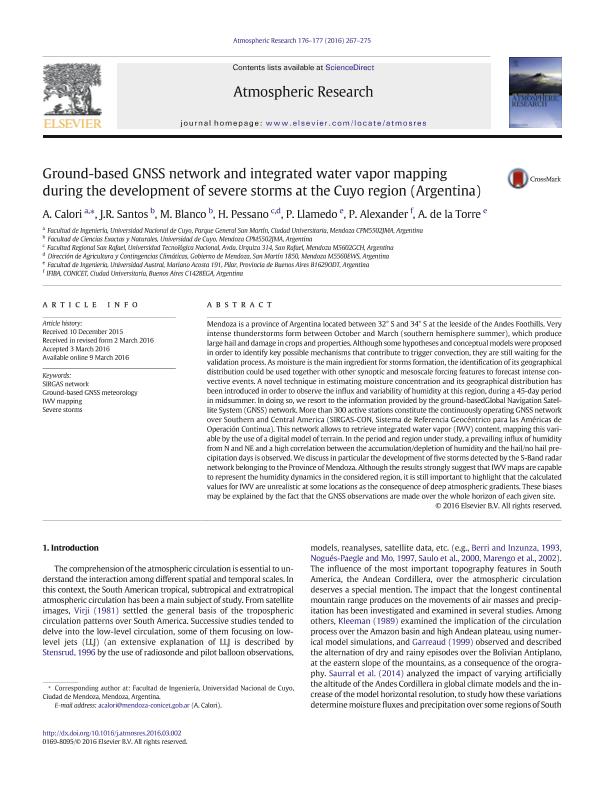Mostrar el registro sencillo del ítem
dc.contributor.author
Calori, Andrea Virginia

dc.contributor.author
Santos, Jorge Ruben

dc.contributor.author
Blanco Moreno, Magalí Valeria

dc.contributor.author
Pessano, H.
dc.contributor.author
Llamedo Soria, Pablo Martin

dc.contributor.author
Alexander, Pedro Manfredo

dc.contributor.author
de la Torre, Alejandro

dc.date.available
2018-06-15T21:10:35Z
dc.date.issued
2016-07
dc.identifier.citation
Calori, Andrea Virginia; Santos, Jorge Ruben; Blanco Moreno, Magalí Valeria; Pessano, H.; Llamedo Soria, Pablo Martin; et al.; Ground-based GNSS network and integrated water vapor mapping during the development of severe storms at the Cuyo region (Argentina); Elsevier Science Inc; Atmospheric Research; 176-177; 7-2016; 267-275
dc.identifier.issn
0169-8095
dc.identifier.uri
http://hdl.handle.net/11336/48891
dc.description.abstract
Mendoza is a province of Argentina located between 32° S and 34° S at the leeside of the Andes Foothills. Very intense thunderstorms form between October and March (southern hemisphere summer), which produce large hail and damage in crops and properties. Although some hypotheses and conceptualmodelswere proposed in order to identify key possible mechanisms that contribute to trigger convection, they are still waiting for the validation process. As moisture is the main ingredient for storms formation, the identification of its geographical distribution could be used together with other synoptic and mesoscale forcing features to forecast intense convective events. A novel technique in estimating moisture concentration and its geographical distribution has been introduced in order to observe the influx and variability of humidity at this region, during a 45-day period in midsummer. In doing so, we resort to the information provided by the ground-based Global Navigation Satellite System (GNSS) network.More than 300 active stations constitute the continuously operating GNSS network over Southern and Central America (SIRGAS-CON, Sistema de Referencia Geocéntrico para las Américas de Operación Continua). This network allows to retrieve integrated water vapor (IWV) content, mapping this variable by the use of a digital model of terrain. In the period and region under study, a prevailing influx of humidity<br />from N and NE and a high correlation between the accumulation/depletion of humidity and the hail/no hail precipitation days is observed.We discuss in particular the development of five storms detected by the S-Band radar network belonging to the Province ofMendoza. Although the results strongly suggest that IWVmaps are capable to represent the humidity dynamics in the considered region, it is still important to highlight that the calculated values for IWV are unrealistic at some locations as the consequence of deep atmospheric gradients. These biases may be explained by the fact that the GNSS observations are made over the whole horizon of each given site.
dc.format
application/pdf
dc.language.iso
eng
dc.publisher
Elsevier Science Inc

dc.rights
info:eu-repo/semantics/openAccess
dc.rights.uri
https://creativecommons.org/licenses/by-nc-sa/2.5/ar/
dc.subject
Ground-Based Gnss Meteorology
dc.subject
Iwv Mapping
dc.subject
Severe Storms
dc.subject
Sirgas Network
dc.subject.classification
Meteorología y Ciencias Atmosféricas

dc.subject.classification
Ciencias de la Tierra y relacionadas con el Medio Ambiente

dc.subject.classification
CIENCIAS NATURALES Y EXACTAS

dc.title
Ground-based GNSS network and integrated water vapor mapping during the development of severe storms at the Cuyo region (Argentina)
dc.type
info:eu-repo/semantics/article
dc.type
info:ar-repo/semantics/artículo
dc.type
info:eu-repo/semantics/publishedVersion
dc.date.updated
2018-05-29T21:12:20Z
dc.journal.volume
176-177
dc.journal.pagination
267-275
dc.journal.pais
Países Bajos

dc.journal.ciudad
Amsterdam
dc.description.fil
Fil: Calori, Andrea Virginia. Universidad Nacional de Cuyo. Facultad de Ingeniería; Argentina. Consejo Nacional de Investigaciones Científicas y Técnicas; Argentina
dc.description.fil
Fil: Santos, Jorge Ruben. Universidad Nacional de Cuyo. Facultad de Ciencias Exactas y Naturales; Argentina
dc.description.fil
Fil: Blanco Moreno, Magalí Valeria. Universidad Nacional de Cuyo. Facultad de Ciencias Exactas y Naturales; Argentina. Consejo Nacional de Investigaciones Científicas y Técnicas; Argentina
dc.description.fil
Fil: Pessano, H.. Universidad Tecnologica Nacional. Facultad Regional San Rafael; Argentina. Gobierno de Mendoza. Dirección de Agricultura y Contingencias Climáticas; Argentina
dc.description.fil
Fil: Llamedo Soria, Pablo Martin. Universidad Austral; Argentina. Consejo Nacional de Investigaciones Científicas y Técnicas; Argentina
dc.description.fil
Fil: Alexander, Pedro Manfredo. Consejo Nacional de Investigaciones Científicas y Técnicas. Oficina de Coordinación Administrativa Ciudad Universitaria. Instituto de Física de Buenos Aires. Universidad de Buenos Aires. Facultad de Ciencias Exactas y Naturales. Instituto de Física de Buenos Aires; Argentina
dc.description.fil
Fil: de la Torre, Alejandro. Universidad Austral; Argentina. Consejo Nacional de Investigaciones Científicas y Técnicas; Argentina
dc.journal.title
Atmospheric Research

dc.relation.alternativeid
info:eu-repo/semantics/altIdentifier/url/https://www.sciencedirect.com/science/article/pii/S0169809516300527?via%3Dihub
dc.relation.alternativeid
info:eu-repo/semantics/altIdentifier/doi/http://dx.doi.org/10.1016/j.atmosres.2016.03.002
Archivos asociados
